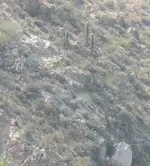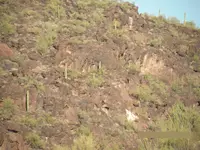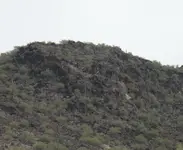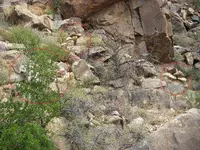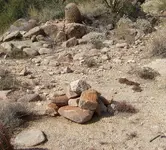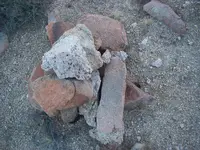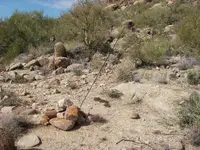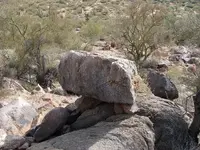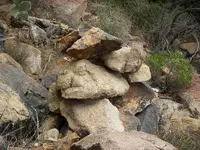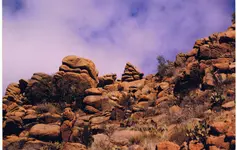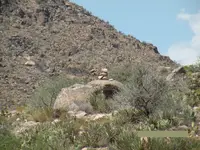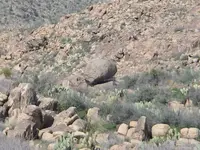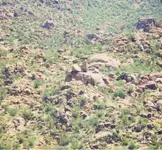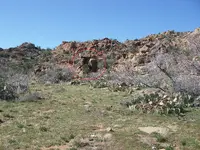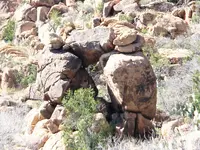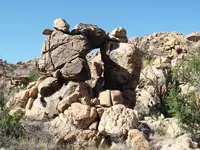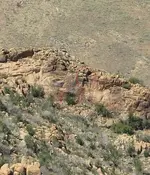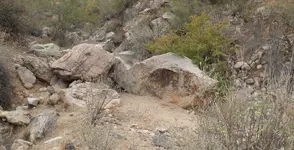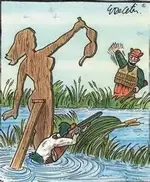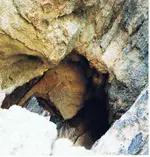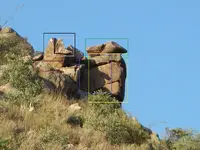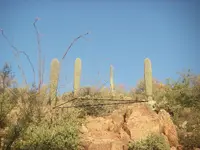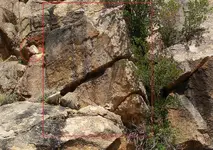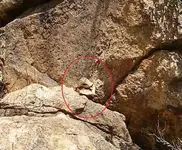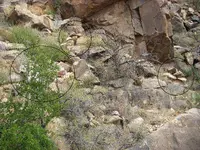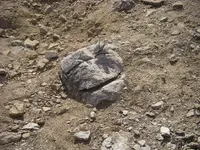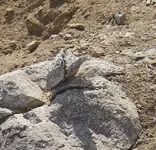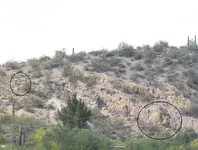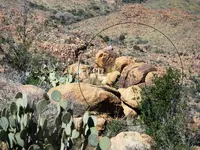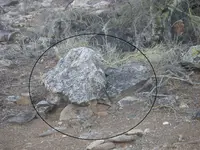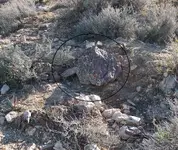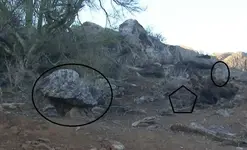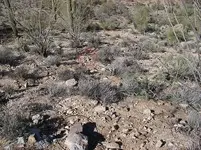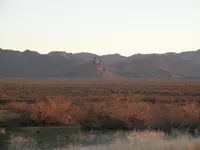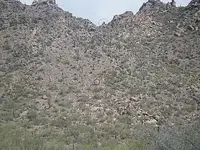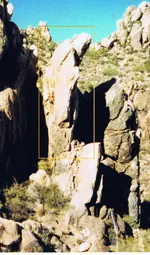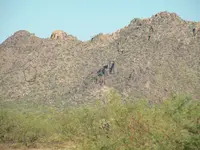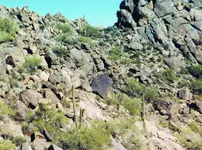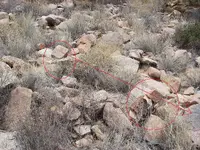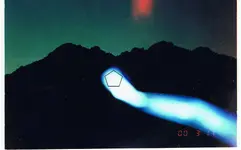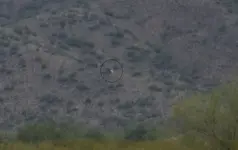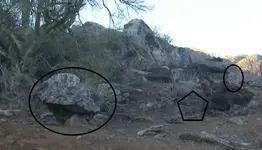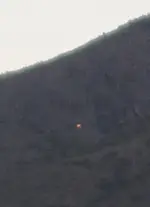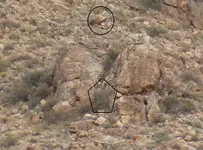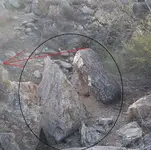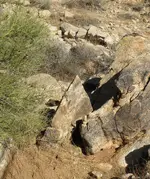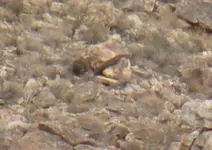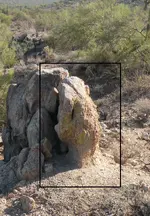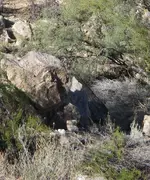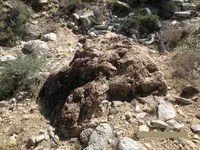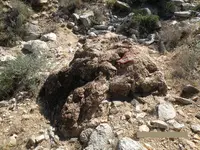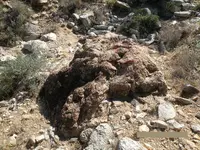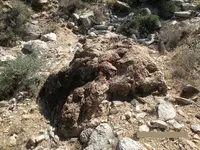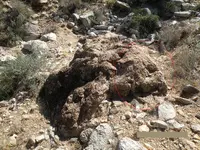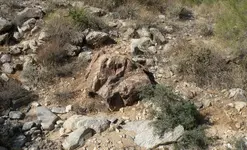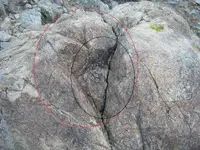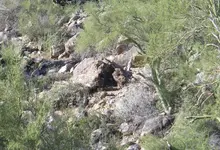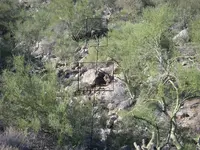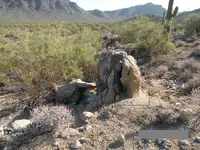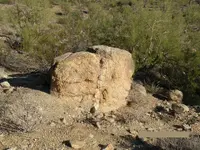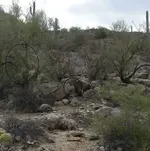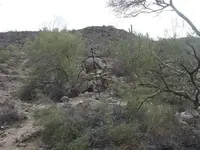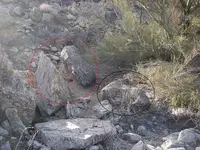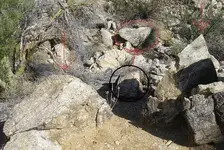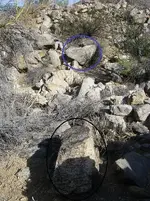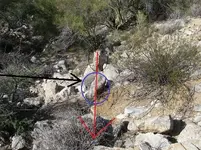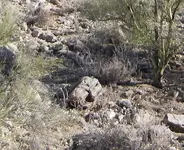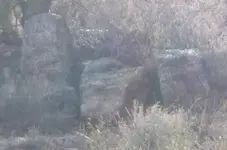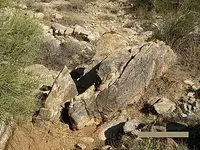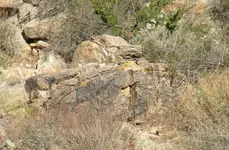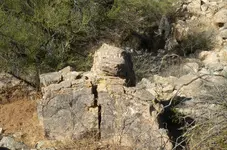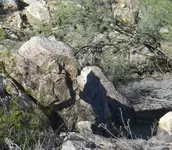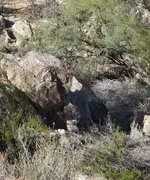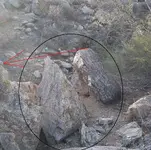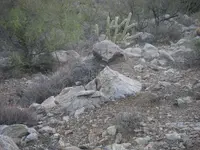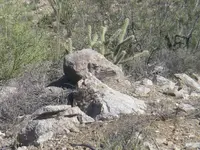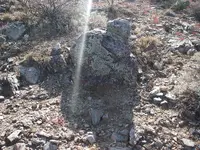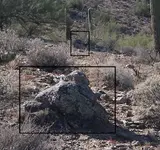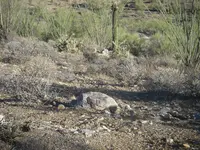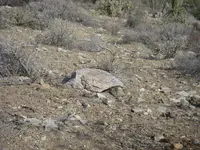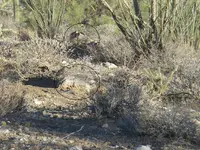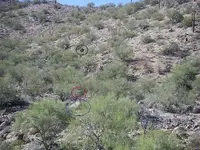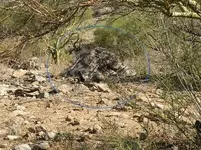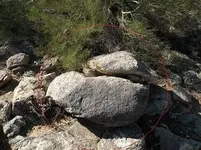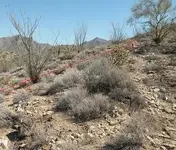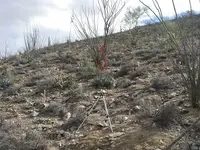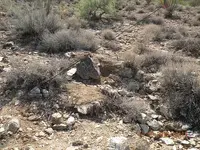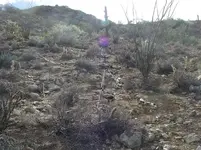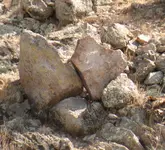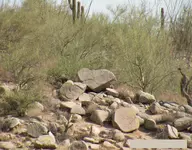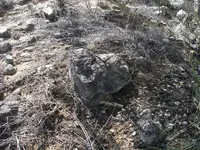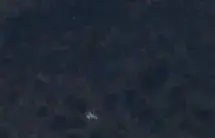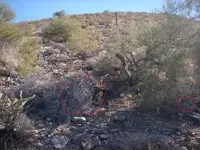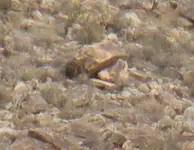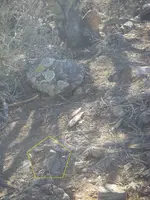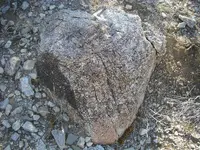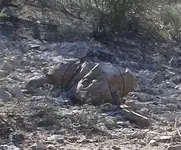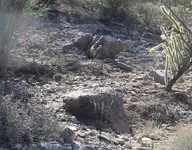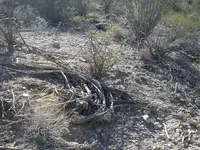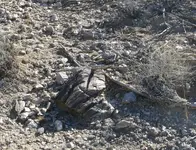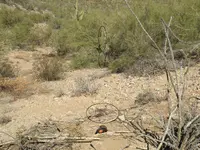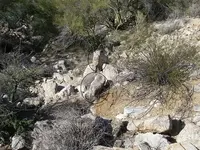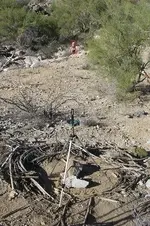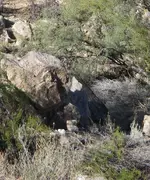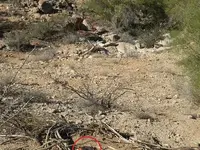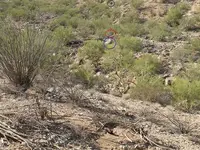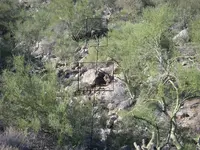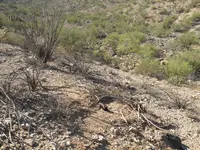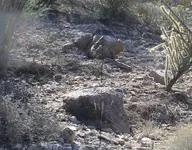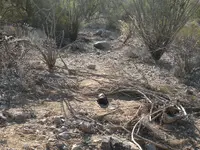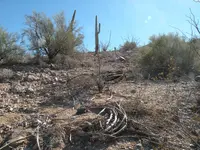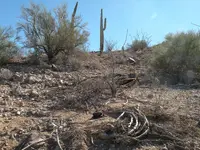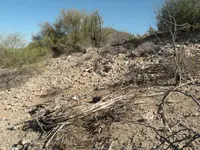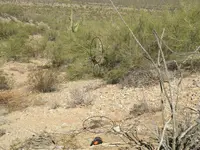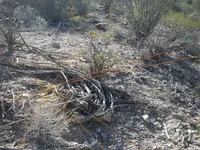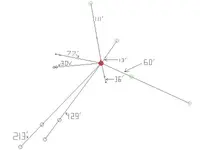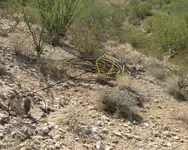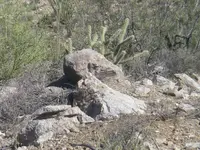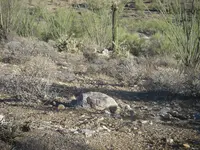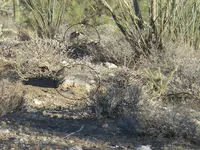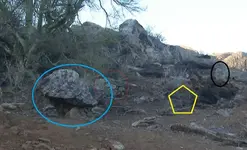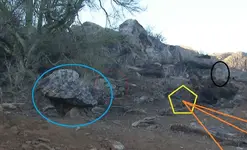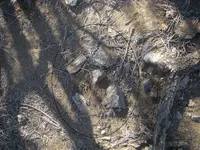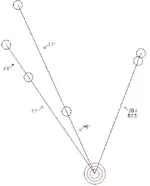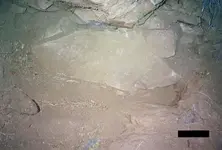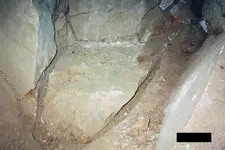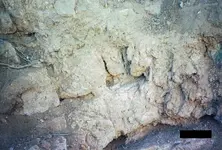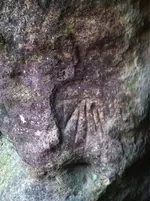sandy1
Bronze Member
- #1
Thread Owner
I have compiled a good list of Real Treasure Markers, that lead to and mark treasure Vaults and Storages
Nobody ever gave me any Information that ever led me to a treasure, that is why I am sharing, because I don't want anybody else to have to go through over half their adult lives to collect this information like I had to.
The United States Government as well as most of the State Governments deny the Existence of Spanish Treasure so who are we to argue with or try to prove them wrong, as they say ignorance is bliss.
(This is dedicated to the young treasure hunters who have tried but cant get any of this information through any other sources)
The First thing I want to mention is that not all markers are Spanish there are many much older Markers that you will encounter in the field and the Spanish knew about these markers and even put their own markers among them, these ancient markers are generally over sized in every way (in other words huge) Any Markers having to do with Christianity such as the Cross, Jesus, Devil etc, are most definitely European as well as animal markers specific to Africa such as the Elephant and Maned Lion.
The markers I will be talking about will be on the smaller side, the Spanish did make large Markers at the beginning of their time in the new world and as time went on into the 17 and 18 hundreds they progressively got smaller down to a hundred pound rock in many cases.
The best way to know if the Spanish were in your area of the country is if you have found stone carved (not glyphs) actual stone carved Turtles in your area then the Spanish or Priests were there. The Best signs to look for to know your in a treasure area (Besides Turtles) are certain types of Triangles (the types I will be showing) as well as Owls and Hearts, generally finding these types of markers means you are in a treasure area.
I will not be mentioning any Bible Verses at all (I have never needed them), and even though the Old Code that I will be using has Holy Symbolism for Animals as well as Holy Distances, it has no Bible Verses, I have never seen anything even remotely resembling information that led to a treasure in the form of a Bible Verse.
I am not a believer in dowsing at all. I have seen people waste their lives trying to find specific treasures with dowsing and never get any closer to the treasure. I wanted to mention this due to the fact that people who have asked for my help wanted to waste my time with dowsing, (dowsing a map) or even messing around with it in the field. The markers are there to be found, and you don't need dowsing for that.
I am a Serious Vault Treasure Hunter and not at all interested in Dowsing, Mining or Metal Detecting (unless the Detecting is used to Locate and Verify where the Treasure is in the Vault)
(#1)
To start out we need some history of why the treasures even exist, so here is a brief summery of the reason for these treasures:
(It all starts with a revolt, The Reason for the Revolt)
The Spanish conquest of the Americas began with two renowned kidnappings for ransom, In 1519 in Tenochtitlan (now Mexico City) the Aztec Emperor Moctezuma was invited to lodge with the Spaniards under the command of Hernan Cortez and then was held for ransom. Moctezuma offered to fill a large room once with gold and twice with silver in return for his freedom. This enormous ransom was duly paid, along with a treasure of jewels, however the Spaniards (history is unclear on this point) either executed or allowed Moctezuma to be killed during an uprising by the Aztecs that started due to brutal mass assassinations of Aztec nobles by the Spanish.
Yet Again in 1531, the Spanish conquistadors under Francisco Pizarro seized the Inca Emperor Atahualpa during a negotiating session, slaughtering many nobles and taking the emperor hostage. Pizarro agreed to release the emperor for a ransom payment of a room twenty-two by sixteen feet filled with gold and silver, when the Incas complied and filled the room, Pizarro fabricated charges that Atahualpa was plotting a counter-revolution and publicly executed the emperor anyway.
Many Natives were tortured and killed in order to find any knowledge of Gold and Silver.
In 1545, silver ore was discovered in Peru, and it changed the way Spain extracted the treasures of the New World. Up to that point, (all precious metals were obtained by stealing it from the natives as well as many more years of looting other ancient places in what is now the USA) (The Spanish were thieves and butchers) After 1545, mining became the main method for the acquisition of precious metals from the Americas. Once mining for silver, became big business in the Colonies, gold took second place, as the metal of choice. In 1546, silver mines were discovered in Mexico, insuring two major sources of silver for Spain. Once mining became more common tens of thousands of Native Americans and Natives from both South and North America as well as Africans were enslaved to work the Spanish Mines. Over time the Spanish moved Northward and started mining in North America the area that would eventually become the USA.
The reason the treasures are still here:
(From 1810 to 1821 was the Mexican Revolution)
Father Migual Hidalgo gathered the Indians, peons, the enslaved and the Mexicans to revolt against Spain's rule. During this eleven year period the Mexicans won their independence from Spain.
Spain was forced to recall its soldiers from the northerly areas (USA) where they were protecting mining communities (because Mexico had won its Independence and would kill any Spaniards on sight after 1821) thousands of treasures large and small were hidden by miners with the intention of returning one day to recover what they hid.
The King had many mines that were worked by slaves and had accumulation rooms for ease of pickup that were not able to be retrieved.
The mines that were owned by individuals (not the king) had to pay taxes 10% to 20% to the king of what was mined and these taxes were put in accumulation rooms as well, many were never retrieved.
In 1846-1848 was the Mexican-American war where America took Mexico's Northernmost lands and thousands of treasure locations with the land, so even the Mexicans only retrieved a small amount of these treasures during the short time of their independence from Spain until America came along (1821-1848 27 years) however the Mexicans left many markers to relocate the treasures later (for themselves of course, not letting America in on their little secret)
(#2)
Now to show my point about how there is a Catholic Theme, here are some pictures.
This is a statue of Jesus Christ at a very old and large Spanish Accumulation/treasure room site. (He is looking directly towards the treasure) (notice the robes and sandals)
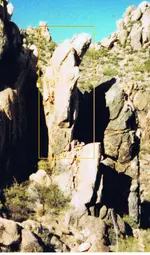
Here is a Shadow Devil that is looking at the same treasure as the Statue of Jesus above from a different angle. (Notice his Horns and tattered Cape)

Here is a large Catholic Cross.
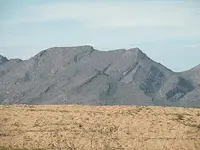
And here is a Shadow Three made by the Catholic Clergy from the 1700's.
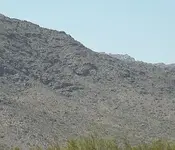
These are all Catholic and Spanish treasure Markers.
(#3)
The Jesuits were into witchcraft and much of what is at treasure sites have to do with witchcraft but the basis for their beliefs was still in Christianity, and yes I have had several ghostly experiences while digging as have most successful treasure hunters, I remember a story Kenworthy told me about hearing a wind up music box the entire time he was inside a vault.
Here is a picture of a Witch that is at one of these treasure sites.
(A Friend In the North West took this Picture)
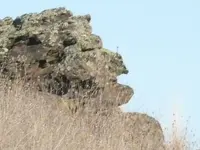
(#4)
There have been different people/groups involved throughout the history of these treasures, the Spanish/Priests/Church the old Mexicans who won their independence, the Sentinels and our very own government (I will touch on these different groups as I go along) So you will find markers that have been built or planted throughout the centuries marking and remarking these treasures all the way up to today.
The big difference between the Mexican/Sentinel markers Compared to the Spanish/Church markers is Permanence, meaning that the Spanish/Church took no chances of anything being accidentally moved off line, they made the markers permanent in a few different ways:
1: they cut into bedrock, or used a boulder that was so heavy it couldn't be moved.
2: they buried markers with a large part of the marker underground and a small amount showing above ground.
3: they were redundant, using multiple markers to mark the treasure storages in case any one of them were destroyed or lost for any reason.
As far as the Mexicans and Sentinels, they use Cairns, Rocks, Saguaros, Trees, stumps, Logs and whatever else they would recognize to help them relocate a site and the entrance easily. (They mapped out their own markers to the entrances, or used them as assistance markers to help find the permanent Spanish markers)
(This remarking is going on to this very day by the Sentinels)
I have used trees and saguaros before at treasure sites, but there is a reason I will keep them to a bare minimum, Anything that was set up by the Spanish or Priests absolutely were required to be permanent, which means, Nothing that can die, anything that can die was only used as assist markers, the important old alignments were Always done in stone, the Sentinels started really using these trees and cactus etc, after Spain's Rule to assist in helping themselves find the old markers as well as the caches, so yes these trees and cactus do go to caches but they are not the original markers to them, and understanding the meaning of the sentinels markers (because many times they only used a map from them) is much more difficult than understanding the old stone markers.
To give an example: you find a saguaro or a tree alone near a treasure with an Owl carving on it, this tree is exactly 45 compass degrees at exactly 13 feet to the treasure, now how do we know this, (we don't), only the sentinels who planted it and mapped it out know its meaning, so this is how they would follow it, their map says look for this Owl on a tree/cactus in this area, then go 45 degrees at 13 feet to the entrance. Now how do we get that information in the field (again, we don't)
There is no rhyme or reason or pattern to follow with trees and cactus, this is because there are no Kings or Church laws for the sentinels to follow, unlike the original permanent markers where there are always patterns that can be learned and reused at different sites.
After finding multiple dig spots, I have measured back to trees and Cactus at sites and the one thing they are known to do is use holy compass degrees and distances, but the only way to know this is after you have found the dig spot with the permanent boulder/carved markers, then reverse engineer the Sentinels tree/cactus and single rock markers from the dig spot.
This is also why the sentinels recheck the different treasure sites (to this day), because over time, the trees and cactus die off and they have to replant new ones, but they do it on new lines and distances that they map out for themselves.
Whenever you look for these treasure sites make sure of two things, 1: that the treasure site is within 20 miles of where you live and 2: that you don't have to hike very far from your vehicle.
The reason is that you will need to travel back and forth to a treasure site multiples times for taking pictures looking for markers etc, so there is no need to waste huge amounts of effort and time when there are literally treasure sites you can just about drive right up to out there. (Yes there really are that many)
(#5)
I am going to start with Treasure Markers you look for at a distance, in the desert you can see for many miles so the Spanish took advantage of this and made many sun and Shadow signs to draw you to a mountain that had treasures on it.
One of the first types of markers that was at the beginning, in many cases on a mountain or seen while in a canyon going to these treasures is the Hole, the hole can be seen from miles away (if large) while others are only meant to be seen from a wash or trail and are fairly small.
These Holes with light/sky showing through them are set up at the trail head to a treasure area.
Not every trail head has a hole.
Here is a Hole that is at the beginning of a mountain range with multiple treasures along it. (This particular hole is the eye of a face, I am slightly off the correct angle to show the nose mouth and chin that are carved on the side ridge, but he is looking towards the storages or More Accurately, towards the storage markers, to the right, so in this case, we go to the right for a couple of miles) (many times the hole is an eye with a carved profile face while other times it is in the shape of something else such as the outline of an Owl etc.)
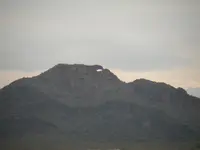
(#6)
This is Going to be one of the Most Important Things I can explain, and I cannot stress this enough:
When the Spanish came back to recover the stored treasures, they did not want to have a hard time finding them so, there were certain rules that had to be followed and one of those is that it was easy to find the markers, this basically means no trying to decipher some cliff face with carvings all over it or trying to find some little stone in the middle of nowhere. I am sure your following the logic here.
Think of it this way could you or I go to a foreign country and try to find a two inch rock on a mountain that we have never seen in a country we have never been to (not a chance in hell)
So they mapped out waterways, washes and tributaries, and these were the roads of the time, then they put up big boulders in these washes (or on the banks) and pointed them in the direction of all kinds of things such as water, camps and of course treasure vault/storages, but only certain markers were for the vault/storages and that is what we are going to discuss, as we move on.
The most important thing to understand is that the Important Treasure Markers are ALONE, as in all by themselves, or at least Really Stand Out by being Over Sized, a Different Color a Shadow Sign, (or in someway different than the surroundings in order to catch your attention)
If for some reason the marker is small then it will have a large marker next to it to draw your attention to the small marker, again these were meant to be very easy to find.
Many times Markers were only meant to be seen while you were on the trail, so some were put flat on the ground. This is by far and away the hardest part of treasure hunting (relocating the old trails) that connected one marker with the next marker which is almost impossible today, due to the fact that time has erased these old trails, all of these storages and markers are connected by trails, washes, wagon trails, without the walking trails, burro trails, wagon roads and washes to follow there would be no hope of the recovery groups ever relocating all the storages. This also includes the boulder markers found at/near the treasures, you have to find the old trails on the hills and walk on them to be able to find and view the treasure markers properly as that is how each marker is connected (by a trail or a wash) However on some markers you use a compass to find the next marker. (more on that later)
They had markers you viewed from long distance (5 miles out) mid range (1 mile to 1/2 mile out) and close up (to within a couple hundred feet) we are going to work on the long range ones for now.
(#7)
Most of the carvings that you see everywhere are not for treasure, only very specific Standalone Markers that are seen from Specific Spots (while on the road/washes and trails) are actually leading to the treasures.(these are the ones I will be covering)
Where You are located/standing viewing the markers from is in many cases more important than the marker itself.
(#8)
The next marker you will see in the desert both made out of rock and sometimes carved/shadow but again by itself (not the trail ones) is the X all by itself on the side of a mountain, anytime you find one of these it means this mountain range holds at least one or more storages, somewhere along it. These are not for pinpointing just to tell you to look along this mountain range for more important markers
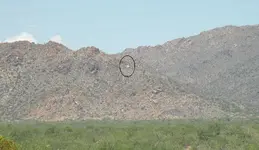
Here is the simple meaning of the X:
Since the 2nd century the Greek letter “X” was used in different monograms, because it was the first letter of Christ’s name.
(Christ or Christós is spelled Χριστός in Greek)
On the large X it confirms (just like the Skull, which will be shown shortly) that this is a place of Christ.
On the small X's, they are confirmation marks that you are on a Holy trail, very similar to finding the carved cross on a rock.
(#9)
Now for the most common of all is the LIT UP BOULDER, these are specifically to call your attention to an area or a mountain (notice how they are Alone as are most of the important markers) many times to accentuate this lit up boulder they placed it right below the peak of a mountain, sometimes they are just on the side of the mountain and angled so they can only be seen when the sun is in the right place some light up in the morning some mid day others in the afternoon, all of these are telling you look at this mountain for more important markers.
Here are a few of mine and all of these have treasure storages near them.
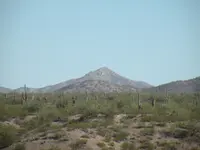
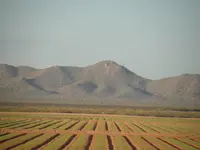
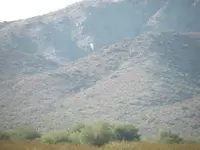
(#10)
Here is another LIT Up Marker that goes to a Major Accumulation room right below it, this is only seen at dawns first light.
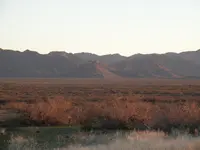
(#11)
When looking at a mountain if you see a Skull this is one of the best signs a treasure hunter can find because it always relates to treasure, so finding one of these means you are on a mountain range with treasure buried on it in most cases multiple caches will be found, as the Spanish and Priests kept multiple storages (not keeping all their eggs in one basket)
When the Skull is made by the Spanish it represents one thing Golgotha the place where Jesus was Crucified at the Calvary or (the place of the Skull)
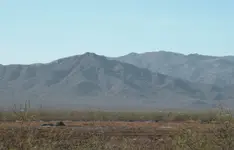
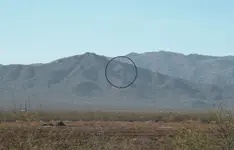
(#12)
Here is another Skull, something to look for when finding a full head or skull is a marker or pointer in one of the eyes that tells you which way to go, since your looking at it head on, you are mostly told to go left or right, unless its a directional arrow.This does not apply to skulls that are on alignments or have other markers around it to follow.
This Skull has a number 3 just to your left of it made out of rocks, the number 3 is most Definitely a Clergy Number Three as no other Culture Used this design so we know it is from Europe and Catholic, which means during The Spanish Era
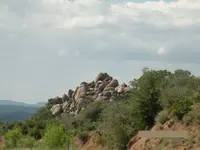
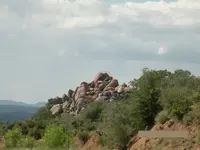
The Number 3's I have shown are the Stamp of the Church and also represent the Trinity.
Far to many people buy into the belief that these signs and treasures are either gone already or only in the Southwest, neither of these are true, there are Spanish or Priests treasures across the entire country, and thousands are still in the ground to this day, which is the reason for the sentinels.
(#13)
When you get a bit closer within a mile or so from the mountain you will start finding markers that are more important, Here are a couple of Shaft Signs (Squared U) that in some cases are found in the ridge line and represent a shaft/storage area.
These two are on mountains that are about 10 miles apart, and each one of these markers have multiple storages within a mile of each of them.
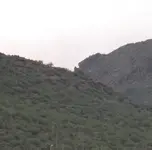
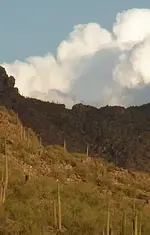
These Large Squared U's are not for pinpointing, but will give you a good section of mountain range to start looking for more important markers, the Shaft Sign is found at the vault/storage areas as well but much smaller (more on that later)
(Notice that these are standalone markers) Most of the Markers I show are going to be alone because that is the only way to spot them easily, and if they are harder to spot then they had a large marker or something that would catch your attention next to or close to it.
(#14)
Here is Another marker you will see from around a mile out from the mountain, it is the Kings Throne this is always found at major accumulation rooms and always alone, so if you see one then within a mile of it is at least one large treasure storage vault.
These Thrones do not give you a clue as to where the treasure storages are just that you need to look for more important markers in the area.
This Throne (in the saddle of the ridgeline) is next to the Jesus Statue I posted before, and the Storage is almost straight down from this Throne.
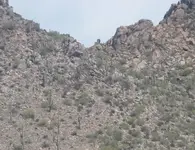
This Throne (on the ridgeline) is about a half mile from another storage (the storage is to your right outside of this picture)
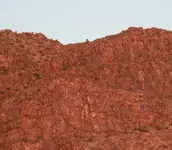
(#15)
Here is another marker you can see from around a mile out from the mountain.
This is the Vertical Line that is designed to show what area to look for storages in, while going down the mountain range (each are separated by at least a half mile) Some of these lines are huge and can be seen from miles away, the ones I have here are much smaller and there are multiples of these going down this mountain range because there are multiple storages along this mountain range, these are not for pinpointing but give you a half mile area to look at for more important markers.
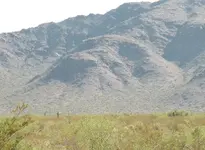
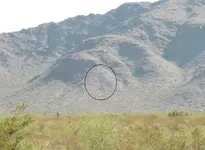
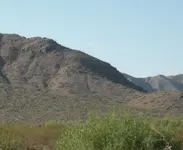
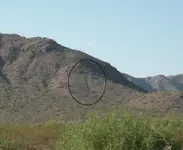
These Vertical Lines are shallow dug out trenches and the best way to view them is when the sun is casting a shadow over these trenches which can be in the morning or late afternoon.
(#16)
Another Thing I want to point out is this, just like the markers were supposed to be easy to spot the storages were meant to be easy to retrieve, if the storage was halfway up a steep cliff then it was probably a mine originally that they used as a storage as well.
The Kings Vaults always had an easy path into them even if it was a wagon path on the side of a hill or just going up a wash to the base of a hill, many of these storages are down in easily accessible areas close to the Base of hills or next to a wash that they could get a wagon up to.
The Smaller Caches are always on a trail that the Burros could pack in and out if they couldn't get the wagon to them.
I try to stay away from rocky cliffs, and you should to, as there are to many chances of a gravity deathtrap just waiting for you to dig under it.
The best treasures to work on are the ones that you will be digging down in the ground with nothing above your head.
(even if it is on the side of a sloped hill)
Gravity death traps are the number one death traps out there.
(#17)
For the next step in our journey, we are going to get closer to the mountain within a half mile, and now we start looking for standalone large boulders that are up against the base of the mountain (or a little ways up it)
These Boulders are marking where to look at on the mountain range, and many times the cache is straight up the hill from these boulders, or they are marking the wash to go up next to them, looking for other Important markers in the wash as you go.
The very best Places to look for Markers are at the base of hills or in the washes and their banks.
Many times the Markers that are marking the caches are below above or side hill to the storage as in Vertical or Horizontal to the hills slope.
Here are a few Standalone Large Boulders (notice again how they are all alone)
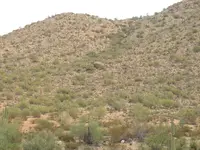
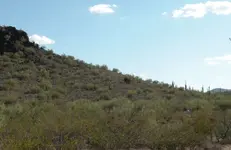
This Boulder is straight below or downhill from the storage, and has a Eagles Head carved on its top.
(Many times the Beginning marker at a site has an Eagle)
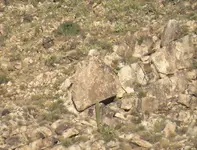
(#18)
I have a lot of people who ask me to read the signs on everything from rocks, trees, cactus etc, and while yes there are certain images you want to find at a treasure site, these writings/signs I will leave to other experts, what I have found to be far more important are the placement and alignments of Boulders/Rocks when you are in close proximity of the treasures.
A good example is this last Eagle head Boulder, it tells us absolutely nothing about which way to go or even what it is there for, but the boulder itself is out of place because of how big it is, here is where only the people who placed it there knew that it was used to mark a treasure, and that the treasure would be straight up the hill from there. (The one thing we do know is that we are viewing this Boulder from the correct angle because the Eagle Head would not be visible from any other angle)
This is the case with most of these markers, only the treasure recovery people knew how to use the markers once they found them. (This is Especially true with the Writing or Maps carved on the boulders, due to them being in code or in many cases just made to lead you on a False Trail)
Last but not least, sometimes there is just a symbol that is carved into a Boulder and the map told them what to do or where to go from the symbol.
Here is an Example:
A Jesuit Priest Buried two mule loads of Gold and Silver, In his Diary he wrote "Locate the Horseshoe carved on a Boulder (in a certain area) then on the first of January at first sunlight a man standing exactly 5'3" stands on top of the Boulder with the Horseshoe carved into it and he will cast a shadow onto the location of the buried hoard of gold and silver.
So even if we happened to find the horseshoe carved in the Boulder, without knowing the details that are in the diary we have no clue how to use this marker, this is why I don't waste my time with rock maps, even if they were meant to be read in the field there would be some unknown code that was only known to the hider of the treasure and not something we would most likely ever figure out in our lifetimes.
This is why the successful treasure hunters use detectors such as Ground Penetrating Radar, Magnetometers as well as Deep Seeking Pulse Induction Detectors. (All are very expensive)
Be wary of People who say they have broken the codes/maps on the Boulders. I have yet to see anybody successfully break the codes/writing on a boulder and have it lead them to a hidden in the ground buried vault (this excludes caves)
Some of the carved animal trail markers will point you in a direction to get you close to the treasure areas but then when you get close the missing information is only known by the initiated,and not found in the field.
Many people will say they deciphered different markers and it may be true that they could get close but every one of these people who have been successful in treasure recovery (when it comes to the treasure buried in the ground not a cave) has ended up using electronics in the end.
In other words, the kings recovery people had extra information that is needed to relocate the treasures which is not shown to us treasure hunters in the field.
This is my goal here, to fill in as many of these missing pieces of information as I can that are not shown in the field.
(#19)
Now I am going to show a combination of several very important signs
As you go along the mountain range a couple things you always want to look for is the Vertical Line and also the OWL, the Owl always means there is at least one storage nearby, and most likely many more. When you see one of these look for the washes going up to it and follow them looking for more markers in the wash or on its banks.
Here is the Owl all by itself (circled) and they Placed him right next to one of the Vertical Lines that I had previously discussed, so the vertical line would be seen from a mile away and then when you got closer you would see this owl, There are at least three small caches within a hundred yards of this owl, also there are two (that I know about) Kings vaults as you walk up the wash that is going towards this owl.
(Down and to the left is the wash, and the vaults)
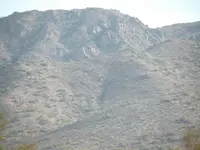
Here is a closeup of the owl and while you will notice that the over all shape is of an Owl, when you zoom in on him, you will find that the Upper portion of his body is actually a Duck going to the right.
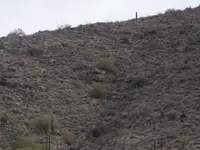
(Marked from the last picture) The Green Circle is the entire body of the owl (this is a very standard type of owl) and the orange arrow is just about touching the beak of the duck which is the head of the owl as well. I am adding an Owl Template for people who don't recognize the shape.
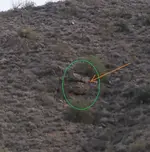
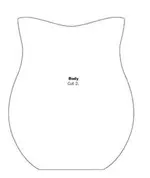
I am also adding a Second Owl from a site many miles away, so I can show that these types of Owls are a standard simple shaped Owl.
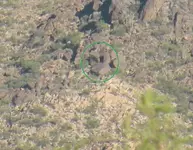
Try to familiarize yourself with these OWL shapes because these are the markers for treasure Vaults.
The owls are usually much smaller when you see them close to the treasures (on the later treasure storages) in some cases just a part of the owl is visible such as half a face or just the eyes or just the horns etc. But I have never ever seen them look towards the treasure however they will be aligned to it (more on that later)
The older sites have larger owls, as time went on into the 1700s the owls became smaller as did most all of the markers. So it wasn't so much about distance from the treasures as it was more about (how old the markers are) when it comes to how large the markers were made. I have seen huge owls very close to treasures at old sites.
(#20)
The Triangle can be seen from three different locations, 1: when your looking at the hill from its base, 2: when you are on a old trail on the mountain itself, or 3: while walking up a wash (on the banks of the wash)
There are Spanish/Church Triangles and Mexican/Sentinel Triangles, the difference is that the Spanish triangles are Permanent and the Mexican/Sentinel Triangles are not.
The Spanish triangle is found at or near sites (within a couple hundred feet) if and only if it is small in other words only under a few feet in size and usually when really close down to a few inches on a large boulder or permanent bedrock, here is the kicker, every triangle I have found (other than a cactus or cairn sentinel triangle) has not helped me in any way to locate the treasures, what they have done is located the final markers or verified the final markers to the treasures, or they were used as an A-Frame alignment Rock and not a triangle (more on the A-Frame later)
It is important to know that when you find a triangle (that is not huge, use my pictures for reference on what size to look for) you are definitely in the immediate area of a treasure, Especially when it is a Mexican/Sentinel Triangle.
The sentinel Triangles are made of trees, cairns, Saguaros, boulders and are always close to the treasure IF they are not bigger than 100 feet around (measuring all the legs and adding them all together) usually less than 50 feet around is much more common.
Here is a Carved Triangle made by the Spanish and is also a Bird Head looking right which is the way to go for the more important markers.
This one is viewed while walking up a wash and tells you the trail turns right and out of the wash. (There is a storage very nearby here as well)
These types of triangles always point out Important markers, so they are very important.
(Notice how this triangle is in a highly visible area this is because it points to something important that is not so visible)
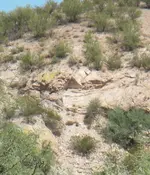
What do you guys say we go on a marker finding journey together.
So one day we decide to go out into the beautiful Arizona sunshine and take a look at a simple Dam Overlook that is State owned and Operated with maintenance crews that check on it all the time.
While we are looking across the lake we notice something interesting, the short wall in front of us has something that shouldn't be there? so what is it that looks strange about this wall?
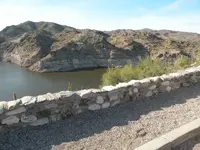
It would appear that there is a Black Triangle on the side of the wall pointing out another triangle that is on the flat top, which you would only see if you were looking down over the top of the wall, so the one on the side would be an eye catcher while the one on the top must be pointing something else out hmm. but first we still need to know if the section of wall with the triangles in it has been replaced at a later date or not. (In other words were the triangles placed long after the wall was built?) The Answer is yes, I have marked the section of the wall that was re cemented in (the Black arrows are the old cement and the blue are the new)(notice the color because the old cement is dirty and porous and the newer cement is much finer textured and cleaner looking) The red Arrow is pointing out the Triangles.
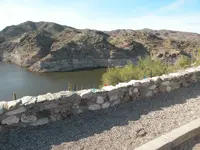
Somehow the Sentinels managed to tear out a section of wall in a State operated Dam Overlook that is being monitored daily and locked up on holidays, then managed to re cement a whole section of it in again hmm.
Now that we have examined the physical evidence as well as what is completely out of place on this wall (the triangles)
We decide its time to look at the top of this wall and what do we find?(on the section that has been replaced, just a few feet from the triangles) We see some writing in the cement.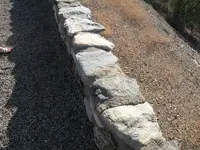
Here are the signs written in the newer cement, in the proper angle they were meant to be seen from.
This code was made by the Spanish or Church to mark and re find treasures, just like the Turtle, the Duck the Owl, the squared U etc. all these are part of the old code, and the sentinels know it very well.
Lets break this message down, shall we, (reading from top to bottom) The S represents the river (so the river is first) the storage which is the Squared U with the heart inside is representing the treasure which is on the other side of the river (because it comes after the river sign)
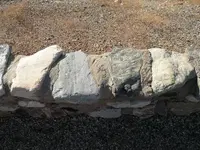
Going a few feet down the wall from the written signs we come to the Triangle, which is how we find the direction to go, So now We shoot out through the alignment stone separate from the triangle (this stone tells us which way to go out of the triangle) it is not dead on (the line would be slightly to the right of this single rock) they actually used a compass at this point, which when I checked it out turned out to be 111 degrees over to... I will show that shortly.
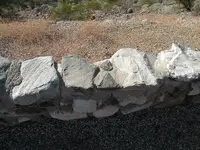
What this means is that the Sentinels had to go along this wall with a Compass until they aligned 111 degrees to a marker on the opposite bank of this lake, then build this triangle at the right spot for it to be on a Holy Degree. There is only a direction given by this triangle (No distance) Which means you go in the compass degree until you come to the next marker.(Besides being holy degrees,111 English Feet is a favorite distance for the sentinels as well)
So we look over in the direction the wall triangle is pointed (across the lake) and wonders never cease another Triangle (Spanish this time) this triangle has a Diamond tip telling us which way to go out of it. So again the sentinels used a Helper triangle to assist in finding the Old markers.
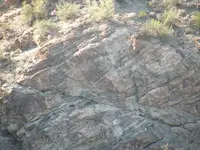
This second one I made for perspective of how to use the wall triangle, to get over to the Spanish triangle (circled in red)
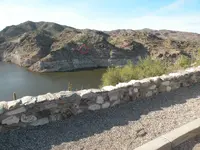
So where do we go from this Spanish Triangle?
Here is what the Spanish triangle points to, a Doorway with a cross in the middle of it, this is just a mock-up of a real doorway that has the actual treasure in it, which just happens to be under the lake, this was put up high so they would be able to find the treasure site while on the opposite bank which is where the trail was. There are other carvings down to the right as well (these markers have been underwater a long time as you can tell by the white stain on the rocks)
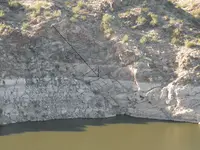
I am sure that the reason the wall triangle went to the Spanish triangle instead of to the doorway is because you could see the Spanish triangle above the water level, but the door was never visible until the water level went down so low recently.
You guys would not believe how many of these storages were covered up with water when Dams were built across the country, because most of the big storages were built on the banks of rivers for ease of locating, so of course when they were dammed up many vaults were flooded over.
The Lesson I had hoped to show here, is that the Sentinels are very real today and they are located everywhere remarking and guarding these treasures (especially online), and second is that the triangles only lead to other markers.
There is Zero chance of recovering this treasure because its in a state park, many of the treasures have been protected by wilderness areas, state trust lands, forestry areas, national parks etc.
These treasures are not lost to the sentinels, just to us, but I hope to change that.
Hopefully You guys realize that the Sentinels who tore down that wall and rebuilt it in a state park surely had permission to do so!!! Which should give you guys a clue as to who the Sentinels are or at least working with.
Nobody ever gave me any Information that ever led me to a treasure, that is why I am sharing, because I don't want anybody else to have to go through over half their adult lives to collect this information like I had to.
The United States Government as well as most of the State Governments deny the Existence of Spanish Treasure so who are we to argue with or try to prove them wrong, as they say ignorance is bliss.
(This is dedicated to the young treasure hunters who have tried but cant get any of this information through any other sources)
The First thing I want to mention is that not all markers are Spanish there are many much older Markers that you will encounter in the field and the Spanish knew about these markers and even put their own markers among them, these ancient markers are generally over sized in every way (in other words huge) Any Markers having to do with Christianity such as the Cross, Jesus, Devil etc, are most definitely European as well as animal markers specific to Africa such as the Elephant and Maned Lion.
The markers I will be talking about will be on the smaller side, the Spanish did make large Markers at the beginning of their time in the new world and as time went on into the 17 and 18 hundreds they progressively got smaller down to a hundred pound rock in many cases.
The best way to know if the Spanish were in your area of the country is if you have found stone carved (not glyphs) actual stone carved Turtles in your area then the Spanish or Priests were there. The Best signs to look for to know your in a treasure area (Besides Turtles) are certain types of Triangles (the types I will be showing) as well as Owls and Hearts, generally finding these types of markers means you are in a treasure area.
I will not be mentioning any Bible Verses at all (I have never needed them), and even though the Old Code that I will be using has Holy Symbolism for Animals as well as Holy Distances, it has no Bible Verses, I have never seen anything even remotely resembling information that led to a treasure in the form of a Bible Verse.
I am not a believer in dowsing at all. I have seen people waste their lives trying to find specific treasures with dowsing and never get any closer to the treasure. I wanted to mention this due to the fact that people who have asked for my help wanted to waste my time with dowsing, (dowsing a map) or even messing around with it in the field. The markers are there to be found, and you don't need dowsing for that.
I am a Serious Vault Treasure Hunter and not at all interested in Dowsing, Mining or Metal Detecting (unless the Detecting is used to Locate and Verify where the Treasure is in the Vault)
(#1)
To start out we need some history of why the treasures even exist, so here is a brief summery of the reason for these treasures:
(It all starts with a revolt, The Reason for the Revolt)
The Spanish conquest of the Americas began with two renowned kidnappings for ransom, In 1519 in Tenochtitlan (now Mexico City) the Aztec Emperor Moctezuma was invited to lodge with the Spaniards under the command of Hernan Cortez and then was held for ransom. Moctezuma offered to fill a large room once with gold and twice with silver in return for his freedom. This enormous ransom was duly paid, along with a treasure of jewels, however the Spaniards (history is unclear on this point) either executed or allowed Moctezuma to be killed during an uprising by the Aztecs that started due to brutal mass assassinations of Aztec nobles by the Spanish.
Yet Again in 1531, the Spanish conquistadors under Francisco Pizarro seized the Inca Emperor Atahualpa during a negotiating session, slaughtering many nobles and taking the emperor hostage. Pizarro agreed to release the emperor for a ransom payment of a room twenty-two by sixteen feet filled with gold and silver, when the Incas complied and filled the room, Pizarro fabricated charges that Atahualpa was plotting a counter-revolution and publicly executed the emperor anyway.
Many Natives were tortured and killed in order to find any knowledge of Gold and Silver.
In 1545, silver ore was discovered in Peru, and it changed the way Spain extracted the treasures of the New World. Up to that point, (all precious metals were obtained by stealing it from the natives as well as many more years of looting other ancient places in what is now the USA) (The Spanish were thieves and butchers) After 1545, mining became the main method for the acquisition of precious metals from the Americas. Once mining for silver, became big business in the Colonies, gold took second place, as the metal of choice. In 1546, silver mines were discovered in Mexico, insuring two major sources of silver for Spain. Once mining became more common tens of thousands of Native Americans and Natives from both South and North America as well as Africans were enslaved to work the Spanish Mines. Over time the Spanish moved Northward and started mining in North America the area that would eventually become the USA.
The reason the treasures are still here:
(From 1810 to 1821 was the Mexican Revolution)
Father Migual Hidalgo gathered the Indians, peons, the enslaved and the Mexicans to revolt against Spain's rule. During this eleven year period the Mexicans won their independence from Spain.
Spain was forced to recall its soldiers from the northerly areas (USA) where they were protecting mining communities (because Mexico had won its Independence and would kill any Spaniards on sight after 1821) thousands of treasures large and small were hidden by miners with the intention of returning one day to recover what they hid.
The King had many mines that were worked by slaves and had accumulation rooms for ease of pickup that were not able to be retrieved.
The mines that were owned by individuals (not the king) had to pay taxes 10% to 20% to the king of what was mined and these taxes were put in accumulation rooms as well, many were never retrieved.
In 1846-1848 was the Mexican-American war where America took Mexico's Northernmost lands and thousands of treasure locations with the land, so even the Mexicans only retrieved a small amount of these treasures during the short time of their independence from Spain until America came along (1821-1848 27 years) however the Mexicans left many markers to relocate the treasures later (for themselves of course, not letting America in on their little secret)
(#2)
Now to show my point about how there is a Catholic Theme, here are some pictures.
This is a statue of Jesus Christ at a very old and large Spanish Accumulation/treasure room site. (He is looking directly towards the treasure) (notice the robes and sandals)

Here is a Shadow Devil that is looking at the same treasure as the Statue of Jesus above from a different angle. (Notice his Horns and tattered Cape)

Here is a large Catholic Cross.

And here is a Shadow Three made by the Catholic Clergy from the 1700's.

These are all Catholic and Spanish treasure Markers.
(#3)
The Jesuits were into witchcraft and much of what is at treasure sites have to do with witchcraft but the basis for their beliefs was still in Christianity, and yes I have had several ghostly experiences while digging as have most successful treasure hunters, I remember a story Kenworthy told me about hearing a wind up music box the entire time he was inside a vault.
Here is a picture of a Witch that is at one of these treasure sites.
(A Friend In the North West took this Picture)

(#4)
There have been different people/groups involved throughout the history of these treasures, the Spanish/Priests/Church the old Mexicans who won their independence, the Sentinels and our very own government (I will touch on these different groups as I go along) So you will find markers that have been built or planted throughout the centuries marking and remarking these treasures all the way up to today.
The big difference between the Mexican/Sentinel markers Compared to the Spanish/Church markers is Permanence, meaning that the Spanish/Church took no chances of anything being accidentally moved off line, they made the markers permanent in a few different ways:
1: they cut into bedrock, or used a boulder that was so heavy it couldn't be moved.
2: they buried markers with a large part of the marker underground and a small amount showing above ground.
3: they were redundant, using multiple markers to mark the treasure storages in case any one of them were destroyed or lost for any reason.
As far as the Mexicans and Sentinels, they use Cairns, Rocks, Saguaros, Trees, stumps, Logs and whatever else they would recognize to help them relocate a site and the entrance easily. (They mapped out their own markers to the entrances, or used them as assistance markers to help find the permanent Spanish markers)
(This remarking is going on to this very day by the Sentinels)
I have used trees and saguaros before at treasure sites, but there is a reason I will keep them to a bare minimum, Anything that was set up by the Spanish or Priests absolutely were required to be permanent, which means, Nothing that can die, anything that can die was only used as assist markers, the important old alignments were Always done in stone, the Sentinels started really using these trees and cactus etc, after Spain's Rule to assist in helping themselves find the old markers as well as the caches, so yes these trees and cactus do go to caches but they are not the original markers to them, and understanding the meaning of the sentinels markers (because many times they only used a map from them) is much more difficult than understanding the old stone markers.
To give an example: you find a saguaro or a tree alone near a treasure with an Owl carving on it, this tree is exactly 45 compass degrees at exactly 13 feet to the treasure, now how do we know this, (we don't), only the sentinels who planted it and mapped it out know its meaning, so this is how they would follow it, their map says look for this Owl on a tree/cactus in this area, then go 45 degrees at 13 feet to the entrance. Now how do we get that information in the field (again, we don't)
There is no rhyme or reason or pattern to follow with trees and cactus, this is because there are no Kings or Church laws for the sentinels to follow, unlike the original permanent markers where there are always patterns that can be learned and reused at different sites.
After finding multiple dig spots, I have measured back to trees and Cactus at sites and the one thing they are known to do is use holy compass degrees and distances, but the only way to know this is after you have found the dig spot with the permanent boulder/carved markers, then reverse engineer the Sentinels tree/cactus and single rock markers from the dig spot.
This is also why the sentinels recheck the different treasure sites (to this day), because over time, the trees and cactus die off and they have to replant new ones, but they do it on new lines and distances that they map out for themselves.
Whenever you look for these treasure sites make sure of two things, 1: that the treasure site is within 20 miles of where you live and 2: that you don't have to hike very far from your vehicle.
The reason is that you will need to travel back and forth to a treasure site multiples times for taking pictures looking for markers etc, so there is no need to waste huge amounts of effort and time when there are literally treasure sites you can just about drive right up to out there. (Yes there really are that many)
(#5)
I am going to start with Treasure Markers you look for at a distance, in the desert you can see for many miles so the Spanish took advantage of this and made many sun and Shadow signs to draw you to a mountain that had treasures on it.
One of the first types of markers that was at the beginning, in many cases on a mountain or seen while in a canyon going to these treasures is the Hole, the hole can be seen from miles away (if large) while others are only meant to be seen from a wash or trail and are fairly small.
These Holes with light/sky showing through them are set up at the trail head to a treasure area.
Not every trail head has a hole.
Here is a Hole that is at the beginning of a mountain range with multiple treasures along it. (This particular hole is the eye of a face, I am slightly off the correct angle to show the nose mouth and chin that are carved on the side ridge, but he is looking towards the storages or More Accurately, towards the storage markers, to the right, so in this case, we go to the right for a couple of miles) (many times the hole is an eye with a carved profile face while other times it is in the shape of something else such as the outline of an Owl etc.)

(#6)
This is Going to be one of the Most Important Things I can explain, and I cannot stress this enough:
When the Spanish came back to recover the stored treasures, they did not want to have a hard time finding them so, there were certain rules that had to be followed and one of those is that it was easy to find the markers, this basically means no trying to decipher some cliff face with carvings all over it or trying to find some little stone in the middle of nowhere. I am sure your following the logic here.
Think of it this way could you or I go to a foreign country and try to find a two inch rock on a mountain that we have never seen in a country we have never been to (not a chance in hell)
So they mapped out waterways, washes and tributaries, and these were the roads of the time, then they put up big boulders in these washes (or on the banks) and pointed them in the direction of all kinds of things such as water, camps and of course treasure vault/storages, but only certain markers were for the vault/storages and that is what we are going to discuss, as we move on.
The most important thing to understand is that the Important Treasure Markers are ALONE, as in all by themselves, or at least Really Stand Out by being Over Sized, a Different Color a Shadow Sign, (or in someway different than the surroundings in order to catch your attention)
If for some reason the marker is small then it will have a large marker next to it to draw your attention to the small marker, again these were meant to be very easy to find.
Many times Markers were only meant to be seen while you were on the trail, so some were put flat on the ground. This is by far and away the hardest part of treasure hunting (relocating the old trails) that connected one marker with the next marker which is almost impossible today, due to the fact that time has erased these old trails, all of these storages and markers are connected by trails, washes, wagon trails, without the walking trails, burro trails, wagon roads and washes to follow there would be no hope of the recovery groups ever relocating all the storages. This also includes the boulder markers found at/near the treasures, you have to find the old trails on the hills and walk on them to be able to find and view the treasure markers properly as that is how each marker is connected (by a trail or a wash) However on some markers you use a compass to find the next marker. (more on that later)
They had markers you viewed from long distance (5 miles out) mid range (1 mile to 1/2 mile out) and close up (to within a couple hundred feet) we are going to work on the long range ones for now.
(#7)
Most of the carvings that you see everywhere are not for treasure, only very specific Standalone Markers that are seen from Specific Spots (while on the road/washes and trails) are actually leading to the treasures.(these are the ones I will be covering)
Where You are located/standing viewing the markers from is in many cases more important than the marker itself.
(#8)
The next marker you will see in the desert both made out of rock and sometimes carved/shadow but again by itself (not the trail ones) is the X all by itself on the side of a mountain, anytime you find one of these it means this mountain range holds at least one or more storages, somewhere along it. These are not for pinpointing just to tell you to look along this mountain range for more important markers

Here is the simple meaning of the X:
Since the 2nd century the Greek letter “X” was used in different monograms, because it was the first letter of Christ’s name.
(Christ or Christós is spelled Χριστός in Greek)
On the large X it confirms (just like the Skull, which will be shown shortly) that this is a place of Christ.
On the small X's, they are confirmation marks that you are on a Holy trail, very similar to finding the carved cross on a rock.
(#9)
Now for the most common of all is the LIT UP BOULDER, these are specifically to call your attention to an area or a mountain (notice how they are Alone as are most of the important markers) many times to accentuate this lit up boulder they placed it right below the peak of a mountain, sometimes they are just on the side of the mountain and angled so they can only be seen when the sun is in the right place some light up in the morning some mid day others in the afternoon, all of these are telling you look at this mountain for more important markers.
Here are a few of mine and all of these have treasure storages near them.



(#10)
Here is another LIT Up Marker that goes to a Major Accumulation room right below it, this is only seen at dawns first light.

(#11)
When looking at a mountain if you see a Skull this is one of the best signs a treasure hunter can find because it always relates to treasure, so finding one of these means you are on a mountain range with treasure buried on it in most cases multiple caches will be found, as the Spanish and Priests kept multiple storages (not keeping all their eggs in one basket)
When the Skull is made by the Spanish it represents one thing Golgotha the place where Jesus was Crucified at the Calvary or (the place of the Skull)


(#12)
Here is another Skull, something to look for when finding a full head or skull is a marker or pointer in one of the eyes that tells you which way to go, since your looking at it head on, you are mostly told to go left or right, unless its a directional arrow.This does not apply to skulls that are on alignments or have other markers around it to follow.
This Skull has a number 3 just to your left of it made out of rocks, the number 3 is most Definitely a Clergy Number Three as no other Culture Used this design so we know it is from Europe and Catholic, which means during The Spanish Era


The Number 3's I have shown are the Stamp of the Church and also represent the Trinity.
Far to many people buy into the belief that these signs and treasures are either gone already or only in the Southwest, neither of these are true, there are Spanish or Priests treasures across the entire country, and thousands are still in the ground to this day, which is the reason for the sentinels.
(#13)
When you get a bit closer within a mile or so from the mountain you will start finding markers that are more important, Here are a couple of Shaft Signs (Squared U) that in some cases are found in the ridge line and represent a shaft/storage area.
These two are on mountains that are about 10 miles apart, and each one of these markers have multiple storages within a mile of each of them.


These Large Squared U's are not for pinpointing, but will give you a good section of mountain range to start looking for more important markers, the Shaft Sign is found at the vault/storage areas as well but much smaller (more on that later)
(Notice that these are standalone markers) Most of the Markers I show are going to be alone because that is the only way to spot them easily, and if they are harder to spot then they had a large marker or something that would catch your attention next to or close to it.
(#14)
Here is Another marker you will see from around a mile out from the mountain, it is the Kings Throne this is always found at major accumulation rooms and always alone, so if you see one then within a mile of it is at least one large treasure storage vault.
These Thrones do not give you a clue as to where the treasure storages are just that you need to look for more important markers in the area.
This Throne (in the saddle of the ridgeline) is next to the Jesus Statue I posted before, and the Storage is almost straight down from this Throne.

This Throne (on the ridgeline) is about a half mile from another storage (the storage is to your right outside of this picture)

(#15)
Here is another marker you can see from around a mile out from the mountain.
This is the Vertical Line that is designed to show what area to look for storages in, while going down the mountain range (each are separated by at least a half mile) Some of these lines are huge and can be seen from miles away, the ones I have here are much smaller and there are multiples of these going down this mountain range because there are multiple storages along this mountain range, these are not for pinpointing but give you a half mile area to look at for more important markers.




These Vertical Lines are shallow dug out trenches and the best way to view them is when the sun is casting a shadow over these trenches which can be in the morning or late afternoon.
(#16)
Another Thing I want to point out is this, just like the markers were supposed to be easy to spot the storages were meant to be easy to retrieve, if the storage was halfway up a steep cliff then it was probably a mine originally that they used as a storage as well.
The Kings Vaults always had an easy path into them even if it was a wagon path on the side of a hill or just going up a wash to the base of a hill, many of these storages are down in easily accessible areas close to the Base of hills or next to a wash that they could get a wagon up to.
The Smaller Caches are always on a trail that the Burros could pack in and out if they couldn't get the wagon to them.
I try to stay away from rocky cliffs, and you should to, as there are to many chances of a gravity deathtrap just waiting for you to dig under it.
The best treasures to work on are the ones that you will be digging down in the ground with nothing above your head.
(even if it is on the side of a sloped hill)
Gravity death traps are the number one death traps out there.
(#17)
For the next step in our journey, we are going to get closer to the mountain within a half mile, and now we start looking for standalone large boulders that are up against the base of the mountain (or a little ways up it)
These Boulders are marking where to look at on the mountain range, and many times the cache is straight up the hill from these boulders, or they are marking the wash to go up next to them, looking for other Important markers in the wash as you go.
The very best Places to look for Markers are at the base of hills or in the washes and their banks.
Many times the Markers that are marking the caches are below above or side hill to the storage as in Vertical or Horizontal to the hills slope.
Here are a few Standalone Large Boulders (notice again how they are all alone)


This Boulder is straight below or downhill from the storage, and has a Eagles Head carved on its top.
(Many times the Beginning marker at a site has an Eagle)

(#18)
I have a lot of people who ask me to read the signs on everything from rocks, trees, cactus etc, and while yes there are certain images you want to find at a treasure site, these writings/signs I will leave to other experts, what I have found to be far more important are the placement and alignments of Boulders/Rocks when you are in close proximity of the treasures.
A good example is this last Eagle head Boulder, it tells us absolutely nothing about which way to go or even what it is there for, but the boulder itself is out of place because of how big it is, here is where only the people who placed it there knew that it was used to mark a treasure, and that the treasure would be straight up the hill from there. (The one thing we do know is that we are viewing this Boulder from the correct angle because the Eagle Head would not be visible from any other angle)
This is the case with most of these markers, only the treasure recovery people knew how to use the markers once they found them. (This is Especially true with the Writing or Maps carved on the boulders, due to them being in code or in many cases just made to lead you on a False Trail)
Last but not least, sometimes there is just a symbol that is carved into a Boulder and the map told them what to do or where to go from the symbol.
Here is an Example:
A Jesuit Priest Buried two mule loads of Gold and Silver, In his Diary he wrote "Locate the Horseshoe carved on a Boulder (in a certain area) then on the first of January at first sunlight a man standing exactly 5'3" stands on top of the Boulder with the Horseshoe carved into it and he will cast a shadow onto the location of the buried hoard of gold and silver.
So even if we happened to find the horseshoe carved in the Boulder, without knowing the details that are in the diary we have no clue how to use this marker, this is why I don't waste my time with rock maps, even if they were meant to be read in the field there would be some unknown code that was only known to the hider of the treasure and not something we would most likely ever figure out in our lifetimes.
This is why the successful treasure hunters use detectors such as Ground Penetrating Radar, Magnetometers as well as Deep Seeking Pulse Induction Detectors. (All are very expensive)
Be wary of People who say they have broken the codes/maps on the Boulders. I have yet to see anybody successfully break the codes/writing on a boulder and have it lead them to a hidden in the ground buried vault (this excludes caves)
Some of the carved animal trail markers will point you in a direction to get you close to the treasure areas but then when you get close the missing information is only known by the initiated,and not found in the field.
Many people will say they deciphered different markers and it may be true that they could get close but every one of these people who have been successful in treasure recovery (when it comes to the treasure buried in the ground not a cave) has ended up using electronics in the end.
In other words, the kings recovery people had extra information that is needed to relocate the treasures which is not shown to us treasure hunters in the field.
This is my goal here, to fill in as many of these missing pieces of information as I can that are not shown in the field.
(#19)
Now I am going to show a combination of several very important signs
As you go along the mountain range a couple things you always want to look for is the Vertical Line and also the OWL, the Owl always means there is at least one storage nearby, and most likely many more. When you see one of these look for the washes going up to it and follow them looking for more markers in the wash or on its banks.
Here is the Owl all by itself (circled) and they Placed him right next to one of the Vertical Lines that I had previously discussed, so the vertical line would be seen from a mile away and then when you got closer you would see this owl, There are at least three small caches within a hundred yards of this owl, also there are two (that I know about) Kings vaults as you walk up the wash that is going towards this owl.
(Down and to the left is the wash, and the vaults)

Here is a closeup of the owl and while you will notice that the over all shape is of an Owl, when you zoom in on him, you will find that the Upper portion of his body is actually a Duck going to the right.

(Marked from the last picture) The Green Circle is the entire body of the owl (this is a very standard type of owl) and the orange arrow is just about touching the beak of the duck which is the head of the owl as well. I am adding an Owl Template for people who don't recognize the shape.


I am also adding a Second Owl from a site many miles away, so I can show that these types of Owls are a standard simple shaped Owl.

Try to familiarize yourself with these OWL shapes because these are the markers for treasure Vaults.
The owls are usually much smaller when you see them close to the treasures (on the later treasure storages) in some cases just a part of the owl is visible such as half a face or just the eyes or just the horns etc. But I have never ever seen them look towards the treasure however they will be aligned to it (more on that later)
The older sites have larger owls, as time went on into the 1700s the owls became smaller as did most all of the markers. So it wasn't so much about distance from the treasures as it was more about (how old the markers are) when it comes to how large the markers were made. I have seen huge owls very close to treasures at old sites.
(#20)
The Triangle can be seen from three different locations, 1: when your looking at the hill from its base, 2: when you are on a old trail on the mountain itself, or 3: while walking up a wash (on the banks of the wash)
There are Spanish/Church Triangles and Mexican/Sentinel Triangles, the difference is that the Spanish triangles are Permanent and the Mexican/Sentinel Triangles are not.
The Spanish triangle is found at or near sites (within a couple hundred feet) if and only if it is small in other words only under a few feet in size and usually when really close down to a few inches on a large boulder or permanent bedrock, here is the kicker, every triangle I have found (other than a cactus or cairn sentinel triangle) has not helped me in any way to locate the treasures, what they have done is located the final markers or verified the final markers to the treasures, or they were used as an A-Frame alignment Rock and not a triangle (more on the A-Frame later)
It is important to know that when you find a triangle (that is not huge, use my pictures for reference on what size to look for) you are definitely in the immediate area of a treasure, Especially when it is a Mexican/Sentinel Triangle.
The sentinel Triangles are made of trees, cairns, Saguaros, boulders and are always close to the treasure IF they are not bigger than 100 feet around (measuring all the legs and adding them all together) usually less than 50 feet around is much more common.
Here is a Carved Triangle made by the Spanish and is also a Bird Head looking right which is the way to go for the more important markers.
This one is viewed while walking up a wash and tells you the trail turns right and out of the wash. (There is a storage very nearby here as well)
These types of triangles always point out Important markers, so they are very important.
(Notice how this triangle is in a highly visible area this is because it points to something important that is not so visible)

What do you guys say we go on a marker finding journey together.
So one day we decide to go out into the beautiful Arizona sunshine and take a look at a simple Dam Overlook that is State owned and Operated with maintenance crews that check on it all the time.
While we are looking across the lake we notice something interesting, the short wall in front of us has something that shouldn't be there? so what is it that looks strange about this wall?

It would appear that there is a Black Triangle on the side of the wall pointing out another triangle that is on the flat top, which you would only see if you were looking down over the top of the wall, so the one on the side would be an eye catcher while the one on the top must be pointing something else out hmm. but first we still need to know if the section of wall with the triangles in it has been replaced at a later date or not. (In other words were the triangles placed long after the wall was built?) The Answer is yes, I have marked the section of the wall that was re cemented in (the Black arrows are the old cement and the blue are the new)(notice the color because the old cement is dirty and porous and the newer cement is much finer textured and cleaner looking) The red Arrow is pointing out the Triangles.

Somehow the Sentinels managed to tear out a section of wall in a State operated Dam Overlook that is being monitored daily and locked up on holidays, then managed to re cement a whole section of it in again hmm.
Now that we have examined the physical evidence as well as what is completely out of place on this wall (the triangles)
We decide its time to look at the top of this wall and what do we find?(on the section that has been replaced, just a few feet from the triangles) We see some writing in the cement.

Here are the signs written in the newer cement, in the proper angle they were meant to be seen from.
This code was made by the Spanish or Church to mark and re find treasures, just like the Turtle, the Duck the Owl, the squared U etc. all these are part of the old code, and the sentinels know it very well.
Lets break this message down, shall we, (reading from top to bottom) The S represents the river (so the river is first) the storage which is the Squared U with the heart inside is representing the treasure which is on the other side of the river (because it comes after the river sign)

Going a few feet down the wall from the written signs we come to the Triangle, which is how we find the direction to go, So now We shoot out through the alignment stone separate from the triangle (this stone tells us which way to go out of the triangle) it is not dead on (the line would be slightly to the right of this single rock) they actually used a compass at this point, which when I checked it out turned out to be 111 degrees over to... I will show that shortly.

What this means is that the Sentinels had to go along this wall with a Compass until they aligned 111 degrees to a marker on the opposite bank of this lake, then build this triangle at the right spot for it to be on a Holy Degree. There is only a direction given by this triangle (No distance) Which means you go in the compass degree until you come to the next marker.(Besides being holy degrees,111 English Feet is a favorite distance for the sentinels as well)
So we look over in the direction the wall triangle is pointed (across the lake) and wonders never cease another Triangle (Spanish this time) this triangle has a Diamond tip telling us which way to go out of it. So again the sentinels used a Helper triangle to assist in finding the Old markers.

This second one I made for perspective of how to use the wall triangle, to get over to the Spanish triangle (circled in red)

So where do we go from this Spanish Triangle?
Here is what the Spanish triangle points to, a Doorway with a cross in the middle of it, this is just a mock-up of a real doorway that has the actual treasure in it, which just happens to be under the lake, this was put up high so they would be able to find the treasure site while on the opposite bank which is where the trail was. There are other carvings down to the right as well (these markers have been underwater a long time as you can tell by the white stain on the rocks)

I am sure that the reason the wall triangle went to the Spanish triangle instead of to the doorway is because you could see the Spanish triangle above the water level, but the door was never visible until the water level went down so low recently.
You guys would not believe how many of these storages were covered up with water when Dams were built across the country, because most of the big storages were built on the banks of rivers for ease of locating, so of course when they were dammed up many vaults were flooded over.
The Lesson I had hoped to show here, is that the Sentinels are very real today and they are located everywhere remarking and guarding these treasures (especially online), and second is that the triangles only lead to other markers.
There is Zero chance of recovering this treasure because its in a state park, many of the treasures have been protected by wilderness areas, state trust lands, forestry areas, national parks etc.
These treasures are not lost to the sentinels, just to us, but I hope to change that.
Hopefully You guys realize that the Sentinels who tore down that wall and rebuilt it in a state park surely had permission to do so!!! Which should give you guys a clue as to who the Sentinels are or at least working with.
Last edited:



